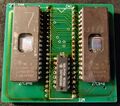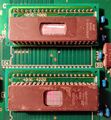Bootleg: Difference between revisions
(Add jump wires) |
|||
| (14 intermediate revisions by 3 users not shown) | |||
| Line 5: | Line 5: | ||
</pre> | </pre> | ||
A "bootleg" commonly refers to a counterfeit game cartridge, CD or [[Bootleg_MVS_boards|system]]. | A "bootleg" commonly refers to a counterfeit game cartridge, [[Copy protection|CD]] or [[Bootleg_MVS_boards|system]]. | ||
NeoGeo bootlegs are quite common, as SNK took years to implement [[ | NeoGeo bootlegs are quite common, as SNK took years to implement [[NEO-CMC|security measures]] to avoid (or at least delay) piracy. Most are believed to originate from China and South Korea. | ||
Over the years, [[multicarts]] gained popularity over single game bootlegs as memory chip costs decreased and decrypted ROMsets became available, making design easier and sales even more profitable. | Over the years, [[multicarts]] gained popularity over single game bootlegs as memory chip costs decreased and decrypted ROMsets became available, making design easier and sales even more profitable. | ||
Aside from the collection and authenticity | Aside from the collection and authenticity aspect, bootlegs are known to be plagued with functional and electrical problems due to low quality manufacturing and/or poor design. | ||
All pictures are crops from [[http://www.mvs-scans.com/index.php/Main_Page MVS-Scans]]. | All pictures are crops from [[http://www.mvs-scans.com/index.php/Main_Page MVS-Scans]]. | ||
| Line 17: | Line 17: | ||
=Recognizing bootleg cartridges= | =Recognizing bootleg cartridges= | ||
Efficiently recognizing bootlegs can be important for collectors, sellers and especially buyers. Some online sellers provide PCB pictures of their MVS games, but many of them only show the label or just an overall view of the cartridge (especially for the home system, as they're | Efficiently recognizing bootlegs can be important for collectors, sellers and especially buyers. Some online sellers provide PCB pictures of their MVS games, but many of them only show the label or just an overall view of the cartridge (especially those for the home system, as they're more difficult to open). | ||
Todo: how to open. MVS: easy, 4 screws. AES: | Todo: how to open. MVS: easy, 4 screws. AES: snapped together. | ||
==Misleading clues== | ==Misleading clues== | ||
* EPROMs ( | * EPROMs (memory chips with glass windows) were sometimes used by SNK for [[P ROM]]s. | ||
* Flux residue around logic chips, might be a repair job. | * Flux residue around logic chips, might just be a repair job. | ||
* A few late cartridges had their [[P ROM]]s replaced by a {{PCB|NGPC flash board|flash daughterboard}}. This is an original emergency solution/fix from SNK. | * A few late cartridges had their [[P ROM]]s replaced by a {{PCB|NGPC flash board|flash daughterboard}}. This is an original emergency solution/fix from SNK. | ||
* Some other late cartridges had a small board ({{PCB|NEO-HYCS}}) wired to [[V ROM]]s and glued on top of them. This is also an original fix. | * Some other late cartridges had a small board ({{PCB|NEO-HYCS}}) wired to [[V ROM]]s and glued on top of them. This is also an original fix. | ||
| Line 30: | Line 30: | ||
==No gold plating== | ==No gold plating== | ||
Original cartridge PCBs all have | Original cartridge PCBs all have gold-plated fingers (slot contacts) for durability. | ||
To reduce costs, some bootleg PCBs | To reduce costs, some bootleg PCBs don't have gold plating (looks dark silver). | ||
This can be checked without opening the cartridge. | This can be checked without opening the cartridge. | ||
| Line 38: | Line 38: | ||
==Unusual chip brands== | ==Unusual chip brands== | ||
SNK had their favorite brands. If found on a cartridge PCB, these chip logos | SNK had their favorite brands. If found on a cartridge PCB, these chip logos can be bad news: | ||
[[File:Bootbrands.png|center]] | [[File:Bootbrands.png|center]] | ||
From left to right, top to bottom: AMD, Atmel, Cypress, Goldstar, Hyundai, Macronix, Microchip, Motorola | From left to right, top to bottom: | ||
* AMD: Memories, never seen on SNK boards | |||
* Atmel: Memories and PLDs, often used in bootlegs | |||
* Cypress: PLDs, often used in bootlegs | |||
* Goldstar: Often found on bootlegs, sometimes on original boards | |||
* Hyundai: Memories, never seen on SNK boards | |||
* Macronix: Memories, never seen on SNK boards | |||
* Microchip: Memories, never seen on SNK boards | |||
* Motorola: Todo, remove | |||
* Samsung: Never seen on SNK boards | |||
* SST: Memories, never seen on SNK boards | |||
* UMC: Rarely seen on SNK boards except for surface-mount memories | |||
* Winbond: Memories, never seen on SNK boards | |||
* Xilinx: Never seen on SNK boards, only Altera | |||
Also Lattice and Intel. | Also Lattice (PLDs) and Intel (flash memories), never seen on SNK boards. | ||
==EPROMs or flash memory== | ==EPROMs or flash memory== | ||
[[File:boot_eprom.jpg|thumb|EPROM | [[File:boot_eprom.jpg|thumb|EPROM chip.]] | ||
EPROMs | EPROMs, memory chips with erasing windows, are often used in bootlegs instead of plain plastic mask ROMs. | ||
Note that some original cartridges use EPROMs as [[P ROM]] revisions | Note that some original cartridges use EPROMs as [[P ROM]] revisions. | ||
<br clear=all> | <br clear=all> | ||
| Line 65: | Line 78: | ||
[[File:boot_pcm.jpg|thumb|{{Chipname|PCM}} clone with a (probably) meaningless marking.]] | [[File:boot_pcm.jpg|thumb|{{Chipname|PCM}} clone with a (probably) meaningless marking.]] | ||
Some chips can be sanded (no markings, visible scratches...) to prevent other bootleggers from copying the design. Clone chips | Some chips can be sanded (no markings, visible scratches...) to prevent other bootleggers from copying the design. Clone chips are often rebranded for the same reason. | ||
<br clear=all> | <br clear=all> | ||
==SMT adapters== | ==SMT or DIP adapters== | ||
[[File:boot_adapter.jpg|thumb|Two 8-bit Intel flash chips used in place of a 16-bit mask ROM.]] | [[File:boot_adapter.jpg|thumb|Two 8-bit Intel flash chips used in place of a 16-bit mask ROM.]] | ||
SMT adapters are small PCBs commonly found in | SMT and DIP adapters are small PCBs commonly found in bootlegs and [[converts]]. They allow the use of cheaper chips in place of EPROMs without having to change the whole board's layout or to use chips not compatible with the board, sometimes with the help of logic ICs. | ||
They were often assembled by hand and therefore covered in flux barf (see below). | They were often assembled by hand and therefore covered in flux barf (see below). | ||
<gallery> | |||
File:boot_adapter.jpg|Two 8-bit Intel flash chips used in place of a 16-bit mask C-ROM. | |||
File:Bootleg-smt-adapter2.jpg|Two 8-bit MX flash chips used in place of a 16-bit mask C-ROM. | |||
File:Bootleg-smt-adapter.jpg|One 8-bit Intel flash chips used in place of a 8-bit mask V-ROM. | |||
File:Bootleg-dip-adapter.jpg|Two 27c040 with logic. | |||
File:Bootleg-dip-adapter2.jpg|Pinout adapter. | |||
File:Bootleg-custom-pcb.jpg|DIP adapter upside-down (on top right). | |||
</gallery> | |||
<br clear=all> | <br clear=all> | ||
==Uncommon board shapes== | ==Uncommon board shapes, colors or layouts== | ||
[[File:boot_shape.jpg|thumb]] | [[File:boot_shape.jpg|thumb]] | ||
As some PCB manufacturers set their price | As some PCB manufacturers set their price depending on the board's area instead of the smallest containing rectangle, some bootleg PCBs were made in unusual shapes to reduce costs. | ||
All known SNK cartridge PCBs are rectangular. | All known SNK cartridge PCBs are rectangular. However it doesn't mean all rectangular boards are original. | ||
Many bootlegs use yellow soldermask (protection lacquer). All known SNK boards use green. | |||
<gallery> | |||
File:boot_shape.jpg|Custom shaped board | |||
File:Bootleg-custom-pcb.jpg|Custom PCB combo: darker color, custom chip marking, DIP adapter | |||
File:Bootleg-custom-pcb-verso.jpg|Same custom PCB, verso | |||
File:boot_yellowmask.jpg|The soldermask gives the board's final color. | |||
</gallery> | |||
<br clear=all> | |||
==Questionable markings== | ==Questionable markings== | ||
| Line 110: | Line 134: | ||
Paper labels are very rare in original cartridges, most manual QC markings were done with colored grease pencils. | Paper labels are very rare in original cartridges, most manual QC markings were done with colored grease pencils. | ||
Prototypes often used paper labels too. | |||
[[File:Proto labels.png|thumb|Paper labels found in prototypes.]] | |||
<br clear=all> | <br clear=all> | ||
==Flux residue== | ==Flux residue== | ||
[[File:boot_flux.jpg|thumb|Extreme case of flux barf.]] | [[File:boot_flux.jpg|thumb|Extreme case of flux barf. Board could still be functional.]] | ||
[[https://en.wikipedia.org/wiki/Flux_(metallurgy) Flux]] used for manual soldering, when not cleaned off, | [[https://en.wikipedia.org/wiki/Flux_(metallurgy) Flux]] used for manual soldering, when not cleaned off, can look like dried barf after a while. | ||
Aside from eventual traces of accidental beer spills, [[corrosion|rat piss]] and dust, original boards should be clean. | Aside from eventual traces of accidental beer spills, [[corrosion|rat piss]] and dust, original boards should be clean. | ||
<br clear=all> | |||
==Lifted pins== | |||
[[File:Bootleg-pin-lift.jpg|thumb|27c010 used as a 27C1000.]] | |||
Commonly found with eprom, lifting pins allows to usage of bigger but cheaper eprom (eg: 27c160 as 27c800) or not compatible eprom (eg: 27c1001 as 27c1000). | |||
<br clear=all> | |||
==Jump wires== | |||
[[File:Bootleg-jump-pcm.jpg|thumb|Jump wire from cart connector to PCM.]] | |||
Some official SNK repairs use jump wires but most of the time having custom wiring is a signature of a bootleg. | |||
This was used to replace 0 ohm resistor (jumper), connect missing address lines of earlier boards in order to get more ROM space or simply to work with non compatible eprom. | |||
<br clear=all> | <br clear=all> | ||
[[Category:Cartridge systems]] | [[Category:Cartridge systems]] | ||
Latest revision as of 00:04, 31 December 2020
From the carrying of bottles of smuggled spirit in the legs of boots.
en.wiktionary.org
A "bootleg" commonly refers to a counterfeit game cartridge, CD or system.
NeoGeo bootlegs are quite common, as SNK took years to implement security measures to avoid (or at least delay) piracy. Most are believed to originate from China and South Korea.
Over the years, multicarts gained popularity over single game bootlegs as memory chip costs decreased and decrypted ROMsets became available, making design easier and sales even more profitable.
Aside from the collection and authenticity aspect, bootlegs are known to be plagued with functional and electrical problems due to low quality manufacturing and/or poor design.
All pictures are crops from [MVS-Scans].
Recognizing bootleg cartridges
Efficiently recognizing bootlegs can be important for collectors, sellers and especially buyers. Some online sellers provide PCB pictures of their MVS games, but many of them only show the label or just an overall view of the cartridge (especially those for the home system, as they're more difficult to open).
Todo: how to open. MVS: easy, 4 screws. AES: snapped together.
Misleading clues
- EPROMs (memory chips with glass windows) were sometimes used by SNK for P ROMs.
- Flux residue around logic chips, might just be a repair job.
- A few late cartridges had their P ROMs replaced by a NGPC flash board. This is an original emergency solution/fix from SNK.
- Some other late cartridges had a small board (NEO-HYCS) wired to V ROMs and glued on top of them. This is also an original fix.
No gold plating
Original cartridge PCBs all have gold-plated fingers (slot contacts) for durability.
To reduce costs, some bootleg PCBs don't have gold plating (looks dark silver).
This can be checked without opening the cartridge.
Unusual chip brands
SNK had their favorite brands. If found on a cartridge PCB, these chip logos can be bad news:

From left to right, top to bottom:
- AMD: Memories, never seen on SNK boards
- Atmel: Memories and PLDs, often used in bootlegs
- Cypress: PLDs, often used in bootlegs
- Goldstar: Often found on bootlegs, sometimes on original boards
- Hyundai: Memories, never seen on SNK boards
- Macronix: Memories, never seen on SNK boards
- Microchip: Memories, never seen on SNK boards
- Motorola: Todo, remove
- Samsung: Never seen on SNK boards
- SST: Memories, never seen on SNK boards
- UMC: Rarely seen on SNK boards except for surface-mount memories
- Winbond: Memories, never seen on SNK boards
- Xilinx: Never seen on SNK boards, only Altera
Also Lattice (PLDs) and Intel (flash memories), never seen on SNK boards.
EPROMs or flash memory
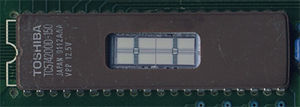
EPROMs, memory chips with erasing windows, are often used in bootlegs instead of plain plastic mask ROMs.
Note that some original cartridges use EPROMs as P ROM revisions.
Bad NGH marking
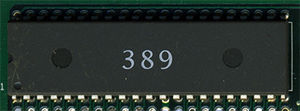
Memory chips only marked with a 3-digit number not matching the game's NGH number are certainly fake.
Sanded or rebranded chips
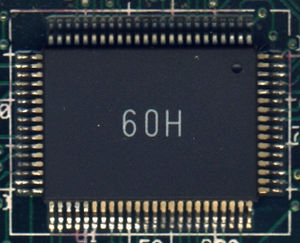
Some chips can be sanded (no markings, visible scratches...) to prevent other bootleggers from copying the design. Clone chips are often rebranded for the same reason.
SMT or DIP adapters
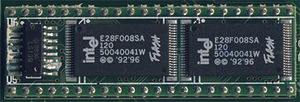
SMT and DIP adapters are small PCBs commonly found in bootlegs and converts. They allow the use of cheaper chips in place of EPROMs without having to change the whole board's layout or to use chips not compatible with the board, sometimes with the help of logic ICs.
They were often assembled by hand and therefore covered in flux barf (see below).
-
Two 8-bit Intel flash chips used in place of a 16-bit mask C-ROM.
-
Two 8-bit MX flash chips used in place of a 16-bit mask C-ROM.
-
One 8-bit Intel flash chips used in place of a 8-bit mask V-ROM.
-
Two 27c040 with logic.
-
Pinout adapter.
-
DIP adapter upside-down (on top right).
Uncommon board shapes, colors or layouts
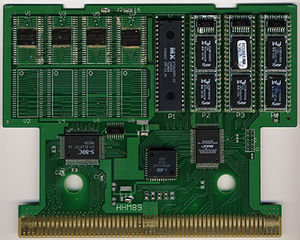
As some PCB manufacturers set their price depending on the board's area instead of the smallest containing rectangle, some bootleg PCBs were made in unusual shapes to reduce costs.
All known SNK cartridge PCBs are rectangular. However it doesn't mean all rectangular boards are original.
Many bootlegs use yellow soldermask (protection lacquer). All known SNK boards use green.
-
Custom shaped board
-
Custom PCB combo: darker color, custom chip marking, DIP adapter
-
Same custom PCB, verso
-
The soldermask gives the board's final color.
Questionable markings
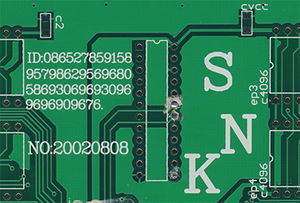
Meaningless "serial numbers", serif fonts, Engrish, bad alignment, bad logo proportions, and wrong line thickness are all signs of fake PCBs.
Sometimes, nothing is better than something (even if no silkscreen at all also means bootleg).
Paper labels
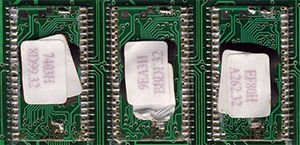
Paper labels are very rare in original cartridges, most manual QC markings were done with colored grease pencils.
Prototypes often used paper labels too.
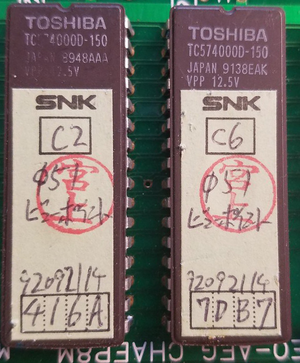
Flux residue
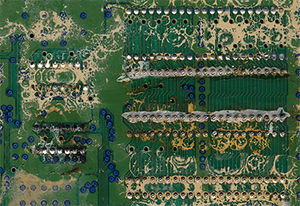
[Flux] used for manual soldering, when not cleaned off, can look like dried barf after a while.
Aside from eventual traces of accidental beer spills, rat piss and dust, original boards should be clean.
Lifted pins
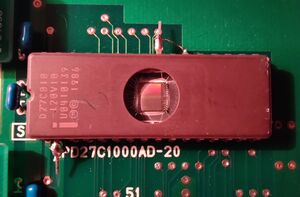
Commonly found with eprom, lifting pins allows to usage of bigger but cheaper eprom (eg: 27c160 as 27c800) or not compatible eprom (eg: 27c1001 as 27c1000).
Jump wires
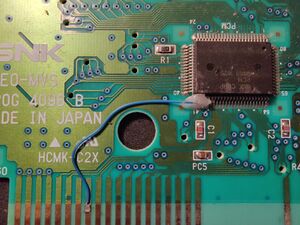
Some official SNK repairs use jump wires but most of the time having custom wiring is a signature of a bootleg.
This was used to replace 0 ohm resistor (jumper), connect missing address lines of earlier boards in order to get more ROM space or simply to work with non compatible eprom.
